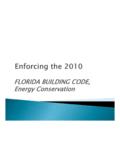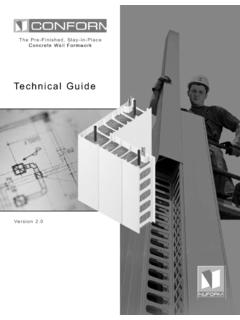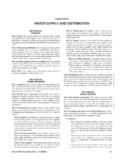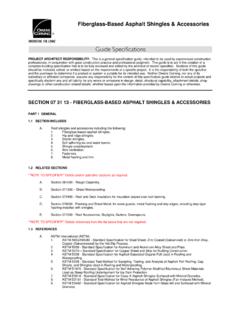Transcription of NFPA 110/111 Update – Understanding the ...
1 nfpa 110 & 111 Update - Understanding the Evolution. Refer to nfpa Disclaimer. A PRESENTATION FOR. 2011 Florida AHCA Seminar nfpa 110/111 Update . Understanding the Evolution David Stymiest, PE, CHFM, FASHE, CEM, GBE. cell Copyright 2011, Smith Seckman Reid, Inc., Nashville, TN. nfpa Disclaimer Although the speaker is Chairman of the nfpa . Technical Committee on Emergency Power Supplies which is responsible for nfpa 110. Supplies, and 111, the views and opinions expressed in this presentation are purely those of the speaker and shall not be considered the official position of nfpa or any of its Technical Committees and shall not be considered to be, nor be relied upon as,as a Formal Interpretation.
2 Interpretation Readers are encouraged to refer to the entire texts of all referenced documents. nfpa members can obtain staff interpretations of nfpa standards at David Stymiest, PE CHFM FASHE, , Copyright (c) 2011 Smith Seckman Reid, Inc. 1. nfpa 110 & 111 Update - Understanding the Evolution. Refer to nfpa Disclaimer. Applicable Revisions Source nfpa 110 nfpa 111. 2009 nfpa 101 Life Safety nfpa 110. 110-2005. 2005 nfpa 111. 111-2005. 2005. Code 2010 FGI Guidelines for Design And Construction nfpa 110-2005 N/A. of Health Care Facilities CMS: Centers for Medicare &. Medicaid Services nfpa 110-1999 nfpa 111-1996. (presently): 2000 nfpa 101. Life Safety Code TJC: The Joint Commission (presently): 2000 nfpa 101 nfpa 110-1999 nfpa 111-1996.
3 Life Safety Code Pending 2012 nfpa 101 Life Safety Code nfpa 110-2010 nfpa 111-2010. (Possible CMS & TJC?). Learning Objectives List the main requirements of nfpa 110-2005 and nfpa 111-2005. 111-2005. Discuss differences between nfpa . 110/111 and standards referenced by national accrediting organizations. Explain p improvements p from 2005 to 2010. editions. List proposals for the 2013 editions that relate to EPSS reliability improvements moving forward. David Stymiest, PE CHFM FASHE, , Copyright (c) 2011 Smith Seckman Reid, Inc. 2. nfpa 110 & 111 Update - Understanding the Evolution. Refer to nfpa Disclaimer. Some major changes in nfpa 110-2005. from previous (2002) edition Improved battery type definitions ( ).
4 Seismic requirements (5 ( ). 1 2). Engine gauge & meter locations ( ). Remote manual stop station ( ). MV generators with unit transformers ( ). ATS listing clarification ( ). Level 1 EPSS not near high energy service equipment ( ). Interior genset working clearance to 36 ( ). Some major changes in nfpa 110-2005. from previous (2002) edition Generator room storage ( ). O td Outdoor generator t lightning li ht i protection t ti ( ). (7 11 4). Notify AHJ of installation acceptance test ( ). Modified installation acceptance test ( ). Modified monthly and annual testing ( ). y 3-year test only y on Level 1 EPSS (( )). Class X (hours of onsite fuel) clarified ( ). Fuel testing & maintenance: new Annex material David Stymiest, PE CHFM FASHE, , Copyright (c) 2011 Smith Seckman Reid, Inc.
5 3. nfpa 110 & 111 Update - Understanding the Evolution. Refer to nfpa Disclaimer. EPSS locations in NP areas [2005 Ed]. Level 1 EPSS equipment shall not be installed in tthe e sa same e room oo with t tthe e normal o a se service ce equipment, where the service equipment is rated over 150 volts to ground and equal to or greater than 1000 amps. Clarifies the clearance distance issues in equipment installations that may be installed in back to back configurations g or along g the same wall. Deleting (which permitted ATS's in normal power areas with twice the NEC clearance). removes the NEC Section confusion and provides additional protection for higher voltage and high amperage services. EPSS locations in NP areas Annex [2005 Ed].
6 The intent of this requirement is to provide maximum fire protection to the most critical critical, high energy systems. Consideration should be given to the potential fire hazard when locating Level 2. EPSS equipment in the normal electrical service room, or to Level 1 systems below 1000 amperes and 150 volts to ground. Clarifies the clearance distance issues in equipment i t installations i t ll ti that th t may be b installed i t ll d in i back to back configurations or along the same wall. Deleting (which permitted ATS's in normal power areas with twice the NEC clearance). removes the NEC Section confusion and provides additional protection for higher voltage and high amperage services.
7 David Stymiest, PE CHFM FASHE, , Copyright (c) 2011 Smith Seckman Reid, Inc. 4. nfpa 110 & 111 Update - Understanding the Evolution. Refer to nfpa Disclaimer. More Genset working clearance [2005 Ed]. The EPS equipment shall be installed in a location that permits ready accessibility and a minimum i i off 0 9 m (36 iin.)) from f the h skid kid rails'. il outermost point in the direction of access for inspection, repair, maintenance, cleaning, or replacement. This requirement shall not apply to units in outdoor housings. Changed clearance distance of 76 cm (30 in.) to .9. m ((36 in.). ) The clearance distance is provided to ensure that maintenance and service can be provided on the equipment.
8 The existing 30 in. barely provided adequate room to bend over or kneel down and work on the equipment. The change to 36 in. will provide adequate room for personnel to work on the equipment. Generator room storage [2005 Ed]. The room in which the EPS equipment is located shall not be used for other purposes p p that are not directly related to the EPS. Parts, tools and manuals for routine maintenance and repair shall be permitted to be stored in the EPS. room. Comment - Allows storage of limited materials t i l ini generator t rooms, and d specifies ifi what MAY be stored. This change was made to facilitate immediate repairs of failed components. David Stymiest, PE CHFM FASHE, , Copyright (c) 2011 Smith Seckman Reid, Inc.
9 5. nfpa 110 & 111 Update - Understanding the Evolution. Refer to nfpa Disclaimer. nfpa 110 Installation Acceptance Test (AHJ witnessed) [2005 Ed]. 1. Simulate primary power failure (full normal power outage) with generator cold start and emergency load at standard operating level. 2. First 2-hour load test uses the actual EPSS building loads (no min. %). 3. First 2-hour load test with actual EPSS loads must use and test all paralleled generators that are intended to be operated simultaneously. 4. After first 2-hour test, NP is re-energized, transfer switches return to NP. 5. EPSS 5 minute cooldown, followed immediately by second 2-hour 2 hour test 6. Second 2-hour full-load test (100% full rated load must be applied in one load step) using load bank with or without building Paralleled generators may be tested individually but each generator is required to run at full load for 2 hours 7.
10 Generator shut down, followed by tests of cycle cranking & safeties 36-month extended load test [2005 Ed]. nfpa 110 extended load test For duration of assigned Class*. Class , for at least 4 hours * nfpa 110 Class: The amount of time the EPSS is required to operate at its rated load without being refueled Use EPSS loads running at the time Open NP breakers/switches that feed transfer switches TJC: Minimum 4 hours, Requires only 30% nameplate loading Dynamic or static load permitted David Stymiest, PE CHFM FASHE, , Copyright (c) 2011 Smith Seckman Reid, Inc. 6. nfpa 110 & 111 Update - Understanding the Evolution. Refer to nfpa Disclaimer. Some major changes in nfpa 111-2005. from previous (2001) edition Complete rewrite to comply with new nfpa .








